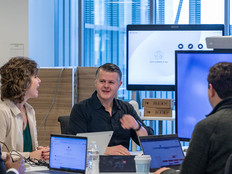Technology Makes Meeting Spaces More Collaborative
At minimum, conference rooms must be video-enabled because at least one attendee will be remote in 9 of 10 meetings, Khan says.
"In addition to conference rooms, offering smaller spaces such as ideation areas, hot desks and jump rooms for quick meetings combines the in-person collaboration benefits with the privacy and quiet of being at home," he adds.
Federal Risk and Authorization Management Program authorization is required for any cloud service provider that has developed a cloud offering designed to work with an agency.
Whenever an agency shares sensitive data in the cloud, it must adhere to FedRAMP standards, which focus on confidentiality, integrity and availability of federal information and include 325 control requirements for Moderate Impact–level security.
Zoom for Government obtained FedRAMP and Department of Defense authorization because that’s the best way to help agencies support hybrid work, with total cost of ownership being an important consideration, says Matt Mandrgoc, head of public sector at .
"We see visual collaboration on a canvas like Zoom Whiteboard as an emerging pillar of effective hybrid work, which is a must so everyone can see and contribute to the board — even if they’re remote," Mandrgoc says. "As spaces evolve to support these highly collaborative meetings, technology must adapt."
One advantage of digital whiteboarding is that it’s available on every device, even after the session ends, Khan says.
"The Webex Whiteboard app is unified across devices, mobile and laptops and stored directly to the users," he says. "That same whiteboard being ideated live in the conference room can also be accessed later and worked on asynchronously."











